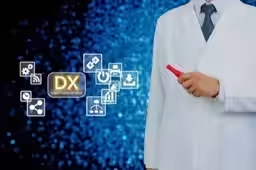

The Rapid Evolution of Clinical Testing and the Role of Technologists in the Age of AI
The Rapid Evolution of Clinical Testing and the Role of Technologists in the Age of AI
As we move toward a future defined by digital transformation (DX) in the clinical testing field, the roles and responsibilities of clinical technologists are undergoing significant changes. With advancements in artificial intelligence (AI) and digital technologies, these professionals are positioned to become key players in the future of healthcare. The implications of this evolution, especially in relation to the anticipated challenges of the 2040 issue, underline the urgency of adapting to an evolving medical landscape.
Understanding Medical DX and Its Implications
Government initiatives such as the Ministry of Health's promotion of electronic health records through smartphone applications highlight the growing importance of integrating technology into healthcare systems. In parallel, private companies and medical institutions are increasingly utilizing AI in diagnostic imaging processes like ultrasound, MRI, and CT scans, all under the umbrella of 'Medical DX'.
Currently, AI plays a supplementary role in clinical testing, with human technologists primarily responsible for conducting tests on specimens and analyzing results. However, as automation and robotics become more prevalent, the testing environment is expected to evolve toward a situation that may require minimal human intervention in the future. This transformation raises crucial questions about how the responsibilities and workflows of clinical technologists will adapt to the rise of digital transformation in clinical testing.
The Current State of DX in Clinical Laboratories
The workflow in clinical laboratories typically involves blood or urine collection, preparation of specimens, measurement, analysis, and reporting of results. Presently, besides sample collection, most stages have started to incorporate DX or AI technologies. As we look ahead, it's anticipated that sample preparation could soon become a thing of the past, giving way to analysis machines that integrate measurement and result analysis into a single unit. The ongoing digitalization trend in specimen analysis machinery and imaging analysis is likely to progress further, suggesting that a fully digital clinical testing environment is not that far off.
The Evolving Role of Clinical Technologists
The drive for increased productivity and operational efficiency posits that clinical technologists should embrace digital tools and innovative technologies while maintaining rigorous data management and quality assurance practices. Ensuring the accuracy of digital measurements and the reliability of test results will continue to rely on the expertise of clinical technologists. This is especially significant in rural healthcare settings, where the demand for enhanced productivity through digital means cannot be overstated.
Leveraging AI for New Insights in Testing
The integration of AI into clinical testing is not only expected to boost productivity but also create new value through the generation of insights derived from extensive data analyses. By employing AI to analyze various data factors related to test results, technologists can support clinicians by providing valuable insights. This represents a shift where clinical technologists could become trusted partners to physicians, aiding in patient care by enhancing their understanding of test data, symptoms, and pharmacology.
Are Clinical Testing Jobs at Risk Due to DX?
Concerns arise surrounding the potential outsourcing of jobs for clinical technologists as a result of DX. However, it’s essential to recognize AI as a tool to enhance human work rather than to replace it entirely. Thus, there is an imperative for technologists to elevate their knowledge, skills, and consciousness. Being equipped to scrutinize AI-generated analyses and validate various datasets equips clinical technologists to continue adding value in clinical settings. Their evolution into experts in data science is an essential trajectory that professional organizations advocate for in response to changing industry demands.
Challenges in Piloting Clinical Testing DX
One of the most pressing challenges clinical technologists face as they embrace new digital technologies is the limited information accessible in their daily routines. To effectively utilize AI systems and derive value from data, they must deepen their expertise and broaden their knowledge base. Moreover, as the push for clinical testing DX persists, fostering a culture of curiosity among technologists and implementing strong leadership to encourage innovation will play crucial roles in shaping the future of clinical testing.
Beyond the Laboratory: Emerging Opportunities for Clinical Technologists
The future of healthcare envisions a scenario where smartphones and other tools enable individuals to manage their health, potentially transforming clinical technologists' roles. This shift is seen as a response to the challenges posed by the 2040 issue. If home testing equipment becomes commonplace, clinical technologists may become vital participants in home healthcare teams, allowing physicians to focus on direct patient interaction. Collaboration where technologists follow up on testing orders can streamline processes, potentially freeing up physicians to see more patients. The increasingly diversified roles for clinical technologists signal exciting prospects beyond traditional laboratory environments.
To explore the full feature article, please visit our dedicated section.
About the Japanese Association of Medical Technologists
Established in 1952, the Japanese Association of Medical Technologists (JAMT) aims to elevate public awareness regarding the importance of skilled clinical technologists. By collaborating with international counterparts, JAMT strives to contribute to the globalization of healthcare.
Details:
- - Name: Japanese Association of Medical Technologists
- - Headquarters: Ota City, Tokyo
- - Founded: July 27, 1952
- - Website: JAMT Official Site




Topics Health)










【About Using Articles】
You can freely use the title and article content by linking to the page where the article is posted.
※ Images cannot be used.
【About Links】
Links are free to use.